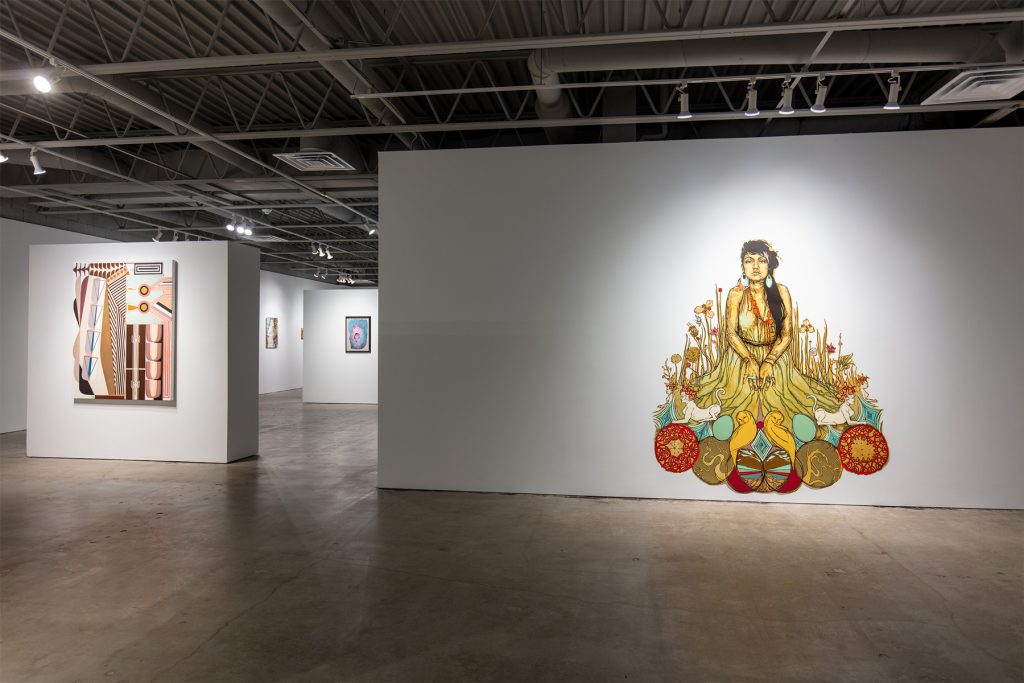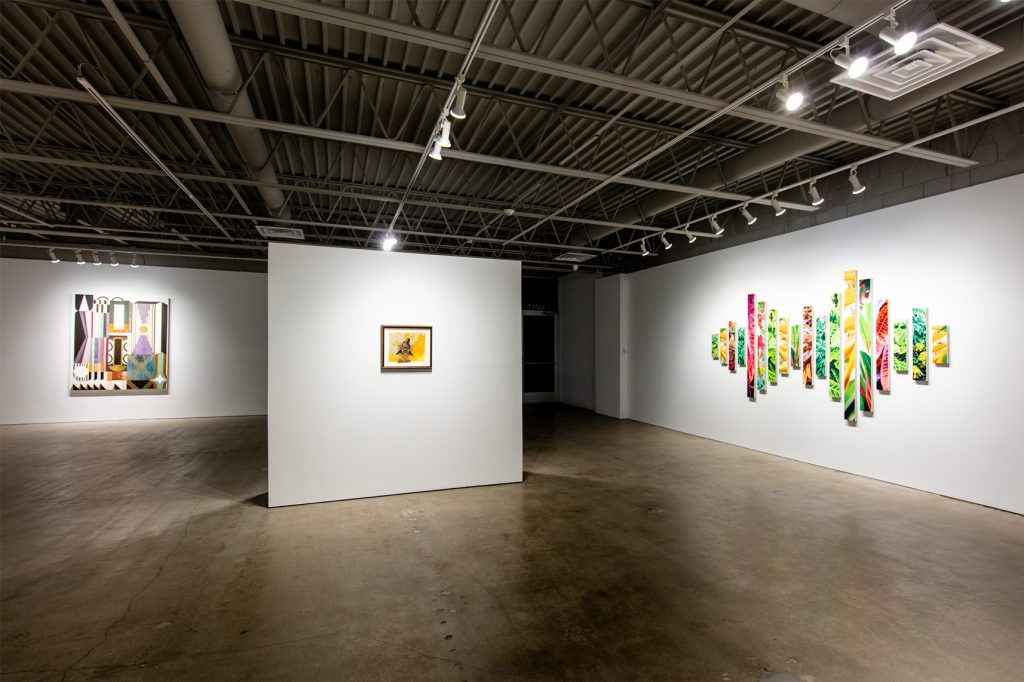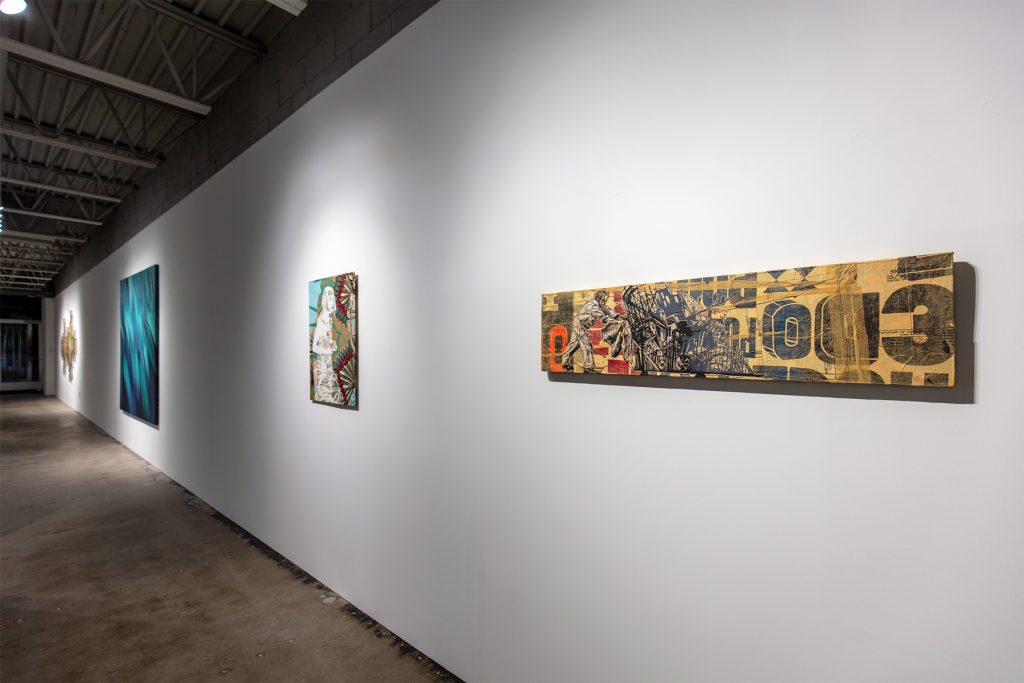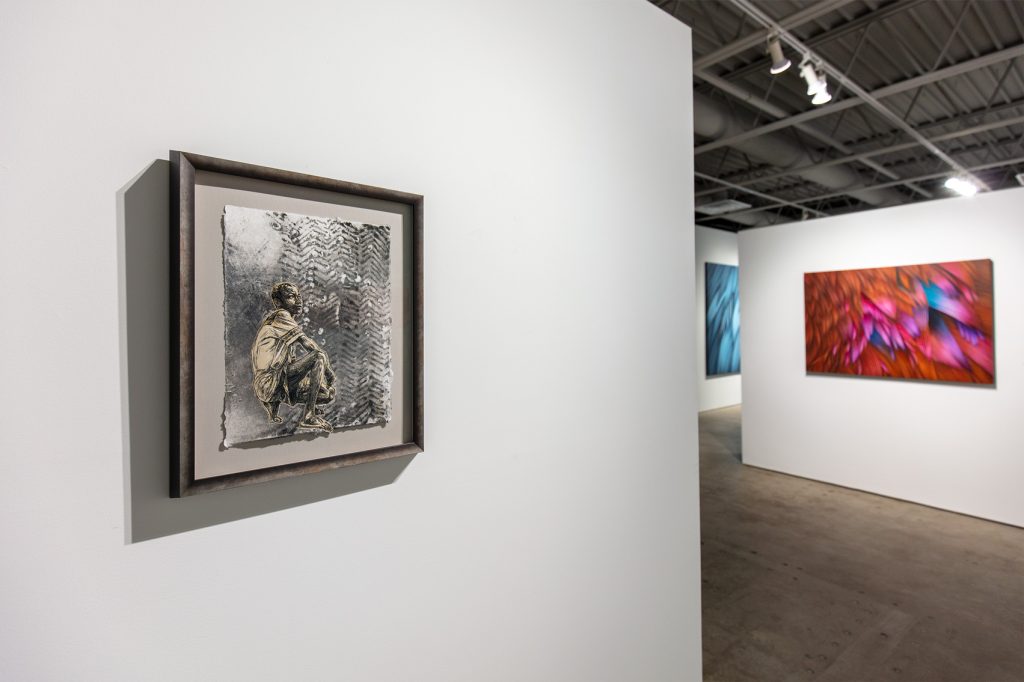TEXT BY MICHAELA MULLIN | VIEW IMAGES
Contemporary Women Artists: Figure and Form
This is an exhibit with the unstated subtitle: Four Strong. Women from around the globe have created artwork that has landed exquisitely in Des Moines, at Moberg Gallery. From Belgium to New York, from Colombia to Colorado, these four artists are painting and plucking, portraiting, photographing, planting, and mathematically abstracting. Swoon, Adele Renault, Alyson Khan, and Goizane Esain each share with us their lens, their world, their creation of critical and massive exploratory work. By magnifying feathers, referencing art deco as a mode of operation, and the witnessing of plant and human as modus vivendi, they gather palette and subject for individual and collective tour de force.
Swoon emerges stories of women, children, and men in “Irina,” “Arielle 4 and 10,” “Meena,” “Sasu and Kasai,” “Kamayura,” and “Street Sweeper.” Using found boards, frames and windows (one with wired glass), Swoon releases the spirit of her subjects, depicting the relationships one has with the self and other, with environment and emotion. What reads as foliage and starburst on pulp and fabric, is the silkscreened “Irina,” who gazes out as in a dream, thoughts raw and inked into her face amidst the finest glitter. Lines of vibration and fantasy is a doubling in “Arielle 4,” nude figures riding upon a floating carnival of black and white weeds and petals. The gradients of magenta in the background make for a majestic air which holds the winged scene, sitting and alighting all at once. “Meena” is a mix of not just media but period, somewhere between British Mod and the namesake of Shiva’s wife, meaning “fish.” In cut paper, block print, and acrylic gouache on wood, the white dress she wears is a stencil of bridge and water, as if the woman’s torso is made of steel and stream and stars.
Adele Renault works in multiple mediums and sizes in “Gutter Paradise 11, 19, 20, 21 and 22.” Two large-scale paintings are done in spray paint on linen, and three in oil on linen. The former paintings have surfaces that are speckled from the aerosol release; the viewer gets close and notices marks made by trajectory and air. In the oil paintings, trompe-l’oeil feathers appear to have floated and landed on the canvases, stuck in the paint so they appear to be both within and atop the surface. There is a sheen of silk in Renault’s oil paintings; and yet when one switches their gaze to the mattified spray paint works, the lack of shine is only a shift in substance, not a loss of. The layering and shadows— repeat and replete with each tier of feathers. These works are a study in the anatomy of feathers, without the taxonomic context of the whole bird. All the plumes, contour, and quill. All the oil slick rainbow and blues. The white light. The rogue one or two feathers, the field of vanes without visible shafts. Renault’s dimensional pillowing of these works makes invitations of the canvases, with the built-in challenge to Do Not Touch.
Alyson Khan draws from math and writing and is an investigative painter whose two new works on display, “The Center Will Hold” and “De-Nest/Departure,” are shapes corseted by math and dressed by color. The geometric and algebraic are calculated and related in Khan’s family album of contour line and interior. A fledged circle is ever-so engraved; an edge is barely deckled, imperfect so the eye can follow it and smooth it in the mind. The bold black complements the paler pink, brown and plum colors, not so much solid but washed, textured, striated, ingrained with patterns of the cumulative and subtractive. Half circles, triangles, moon-like pendant and column are basic in their aspiration to be both historical and contemporary. Building blocks that sit and rest in two dimensions, filling the box that is a frame, making gaps that solidify as shapes in absentia.
Goizane Esain’s lush photographic work on aluminum, “A Piece of Tropic,” is divided into seventeen pieces of a piece. Greens, pinks, and yellows. Variegated leaves and story— of flora gone wild, of the up/rootedness of reality and the vibrant escape that art offers the eyes and mind. Each vertical section contains a world of textured hue that draws us in to look at the granular, and gently steps us back to take in the entirety of the fragmented yet non-chronological whole. No matter if Esain is photographing sculpture or architecture, land or cityscape, her astute eye cuts the image at unexpected moments, and in doing so, pushes our thinking into an understanding of the achronological as it affects place and disorders what we consider to be natural visual hierarchy. The inextricable nature of time and place is evident in Esain’s use of sun and site, of natural diffuse light and herself.
View works on mobergshop.com
Exhibit Images






























